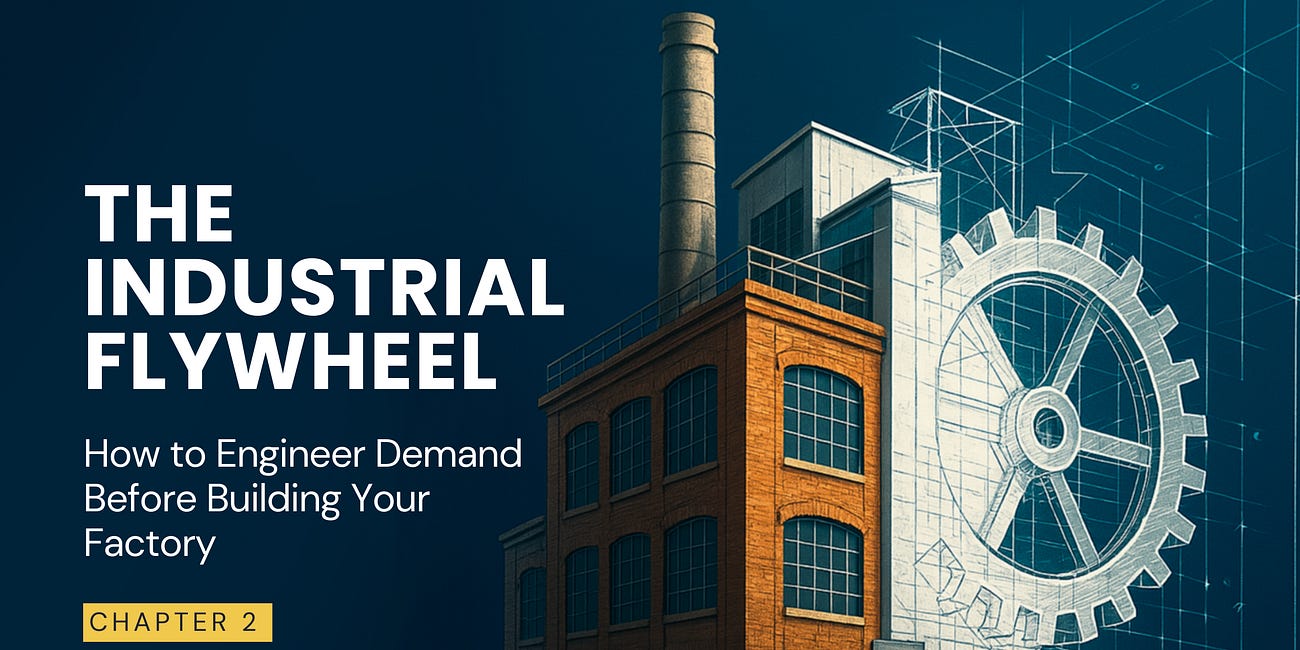⚔️ Anduril Copperhead; 🌕 MOU for Lunar Ops; 🪫Sodium-Ion Battery Shut Down; 🔋 Grid-Ready Organic Flow Battery; 🧱 Microsoft Bets on Carbon Capture for Heavy Industry & more | Deep Tech Briefing #56
Weekly Intelligence on Deep Tech Startups and Venture Capital.
Thanks for reading Deep Tech Briefing, our weekly intelligence on deep tech startups and venture capital. If you like what you see, I encourage you to subscribe to all our pieces here.
Dear Friends,
The terrain of deep tech is shifting—not with a bang, but with the quiet hum of infrastructure being reimagined.
This week, signals of strategic realignment echoed across sectors that rarely share headlines but now seem to rhyme. In subsea defense, industrial energy, aerospace supply chains, and synthetic biology, a common narrative is emerging: the transition from moonshot to manufacturable, from theory to throughput.
Let’s start underwater. For decades, the ocean’s depths have existed beyond the reach of scaled autonomy—untouched not for lack of interest, but because the economics and logistics didn’t make sense. That calculus is beginning to change. The recent unveiling of a modular undersea platform built around mass production, not bespoke systems, points to a new kind of industrial logic entering the maritime battlespace. What mattered this week wasn’t the novelty of the tech, but its manufacturability—and the doctrine it enables.
On land, that same shift was mirrored in energy storage, where a new grid-scale battery concept emerged not from lithium, vanadium, or any of the usual suspects—but from an organic molecule designed to flow. This isn’t just chemistry; it’s an attempt to reset the baseline assumptions around safety, scalability, and unit economics for long-duration storage. With modular tank architecture and off-the-shelf infrastructure, it might just get there.
The aerospace world, for its part, is increasingly focused on the middle. Not moonshots, but mid-tier components—those unassuming yet indispensable parts that sit between systems and often dictate their success or failure. A new strategy is emerging: revive legacy manufacturing capacity, rewire it with modern engineering, and reintegrate it into an industrial base long overdue for reinvestment. If executed well, this could quietly improve lead times, reliability, and sovereign resilience across the sector.
Meanwhile, on the chemistry frontier, a different kind of scale-up is underway. One biotech initiative is attempting to break free from simulation-heavy models and instead physically synthesize drug-like molecules—hundreds of thousands per day—with the help of automation and AI. It's not just an efficiency play; it's a philosophical one. In complex therapeutic areas where targets are poorly understood and libraries are sparse, the ability to explore chemical space at scale could reshape what early-stage drug discovery looks like.
This week also brought developments in surgical imaging, carbon removal, wafer-scale compute, and nuclear fuel supply chains—all carrying the same underlying message: the future is increasingly shaped by what can be manufactured reliably, integrated seamlessly, and deployed at scale.
To be clear, many of these efforts remain works in progress. Capital markets are selective. Supply chains are stretched. And regulatory frameworks often move more slowly than the technology they aim to govern.
But if you zoom out, the arc is visible. Across multiple verticals, the conversation is less about hypothetical promise and more about delivery pathways. The ideas are still ambitious—but now they come with plans, partners, and pilot sites.
As always, the nuance lives in the details.
Let’s dive in.
✨ For more, see Membership | Venture Guides | Insights | Deep Tech Catalyst
In Today's Briefing
The Big Idea – A new family of modular, autonomous underwater vehicles is designed for mass production—marking a strategic shift toward scalable, cost-effective subsea systems and a rethinking of undersea deterrence.
The Key Updates – A battery startup shuts down its sodium-ion program as market dynamics shift. A new aerospace venture targets neglected mid-tier suppliers to rebuild U.S. depth. Autonomy pivots from hardware to software, while insect farming hits financial limits. Organic flow batteries scale to the grid, AI on the battlefield faces mixed feedback, and carbon removal focuses on retrofitting heavy industry. Surgical platforms move toward real-time data, and wafer-scale AI clusters arrive in Europe.
Breakthroughs and Discoveries – New quantum spin control boosts sensor performance. Fluorine-free repellents rival PFAS. 3D-printed drone swarms test military scalability. A soft robotic gripper built from tape rethinks dexterity. PFAS waste is upcycled into graphene, while ultra-thin semiconductors run full processors. Radiation detectors shrink without losing precision, and sodium coolant gets safely solidified—solving a nuclear decommissioning challenge.
Deep Tech Power Plays – A $15B federal plan could reboot U.S. biotech. The UK backs fusion with a state-seeded venture fund. Europe launches an AI adoption and infrastructure push. Canada approves the first G7 small modular reactor build.
Before Go Ahead:
Deep Tech Briefing is just one part of The Scenarionist experience. To enjoy the full experience, become a Premium Member!
The Scenarionist Premium is designed to make you a better Deep Tech Founder, Investor, and Operator. Premium members gain exclusive access to unique insights, analysis, and Venture Guides with the wisdom of the world’s leading Deep Tech thought leaders. Invest in yourself, and upgrade today!
Interesting Reading:
The deeper you dig, the weirder, wider, and more telling the world of deep tech becomes. Here are a few standout reads from this week:
Semiconductors: can European industry regain ground?
Once ahead, now behind—Europe’s chip ambitions are back on the table.
— Polytechnique InsightsAgrifoodtech VC: Trade war will ‘make food security an urgent priority’
A geopolitical cold front is rewriting the future of what—and how—we eat.
— AgFunderNewsUniversity of Illinois to host first KRONOS MMR
A small reactor, a big leap: nuclear innovation lands on campus.
— Nuclear Engineering InternationalAI models can help generate cleaner power
What if the future of energy isn’t just renewable—but algorithmically optimized?
— The EconomistStarlink’s rise in the defense market forces industry to adapt
A commercial constellation becomes the Pentagon’s secret weapon.
— SpaceNewsMarine Corps to field counter-drone systems to dismounted units
The next battlefield won’t be man vs. machine—it’ll be man against machines in the sky.
— Defense OneDOE Allocates First Round of HALEU to Five U.S. Advanced Nuclear Reactor Developers
With HALEU flowing, America’s next-gen reactors move from blueprint to reality.
— Power MagazineTrump tariffs force European hardware startups into crisis mode: ‘Planning is now impossible’
For hardware founders in Europe, geopolitics is the new product risk.
— SiftedVenture Fundraising, Deals Put on Pause
For VCs and startups, 2025 is starting to feel like 2008 in slow motion.
— The Wall Street JournalMarket Volatility to Drive Closer Collaboration Between Biotech Startups, Large Pharma
When capital recedes, alliances surge—especially in life sciences.
— The Wall Street JournalDeath of a Sodium-Ion Battery Startup
A high-potential lithium alternative meets the hard edge of market reality.
— Heatmap
The Industrial Flywheel: How to Engineer Demand Before Building Your Factory | Chapter 2
If you're building in deep tech, you already know: you don’t get the luxury of launching with code and scaling with servers.
You're dealing with physical products. Real-world physics. Factories that cost millions—before your first unit ever ships.
So, how do you create market pull before your production line even exists?
In Chapter One, we reframe go-to-market for industrial founders—not as a late-stage effort, but as a core part of your R&D strategy. We show you how to align with pilot partners, investors, and regulators before the concrete is poured. How to turn demand signals—MOUs, LOIs, early pilots—into levers for traction and capital.
In Chapter Two, we take you inside the pilot phase: how to fund it, structure it, and use it to cross the credibility gap between prototype and full production. You'll learn how to turn a successful test into real-world adoption, contractual commitments, and investor-grade data—while avoiding the traps that kill momentum during scale-up.
Whether you’re pioneering advanced materials, quantum sensors, synthetic biology platforms, or next-gen robotics, the principle stays the same: you must engineer the demand while you engineer the technology.
So...What if your factory could sell before it exists?
The Big Idea:
Anduril Unveils Copperhead: A Closer Look at the Future of Subsea Defense Through Modularity and Mass Production
For decades, the ocean floor has been treated as the final frontier of autonomy — a domain defined more by opacity than by innovation. While the air and surface domains have undergone waves of transformation, driven by advances in robotics, sensing, and rapid iteration, the undersea world has remained largely bound to an older industrial rhythm.
That may be starting to change.
This week, Anduril Industries introduced Copperhead, a new family of autonomous underwater vehicles (AUVs) designed to address defense-related subsea use cases. The product line includes two main sizes — Copperhead-100 and Copperhead-500 — each offered in both standard and munition-capable variants. All models are designed to be deployed by other autonomous platforms, including Anduril’s own Dive-XL submarine, enabling scalable, unmanned coverage of critical maritime areas.
In principle, this is not a dramatic technological leap. The concept of deploying smaller vehicles from a larger mothership is well established in both aerospace and defense. But applying this logic to the underwater domain — with production volume, modularity, and cost-efficiency as core design principles — may prove strategically significant.
The undersea battlespace has long been defined by scarcity. Torpedoes are expensive, slow to manufacture, and typically tied to high-value, manned platforms. The U.S. Navy’s Mk 48, a long-standing heavyweight torpedo, reportedly costs over $3 million per unit and is primarily launched from nuclear submarines. That cost structure imposes limits on flexibility and creates a bias toward deploying such munitions only in high-risk, high-value engagements.
Copperhead introduces a different framework.






